AMD FX-8320E CPU Review: The Other 95W Vishera
by Ian Cutress on January 13, 2015 10:00 AM ESTProfessional Performance: Windows
Agisoft Photoscan – 2D to 3D Image Manipulation: link
Agisoft Photoscan creates 3D models from 2D images, a process which is very computationally expensive. The algorithm is split into four distinct phases, and different phases of the model reconstruction require either fast memory, fast IPC, more cores, or even OpenCL compute devices to hand. Agisoft supplied us with a special version of the software to script the process, where we take 50 images of a stately home and convert it into a medium quality model. This benchmark typically takes around 15-20 minutes on a high end PC on the CPU alone, with GPUs reducing the time.
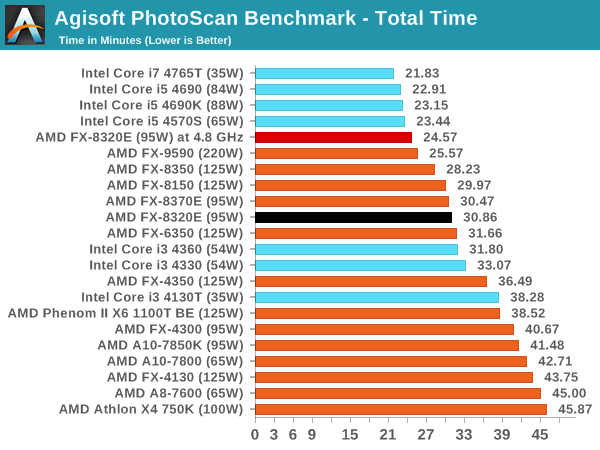
A highly parallel benchmark like Photoscan puts the FX CPUs ahead of our i3 results. When overclocked, it plays just behind the i5 results.
Cinebench R15
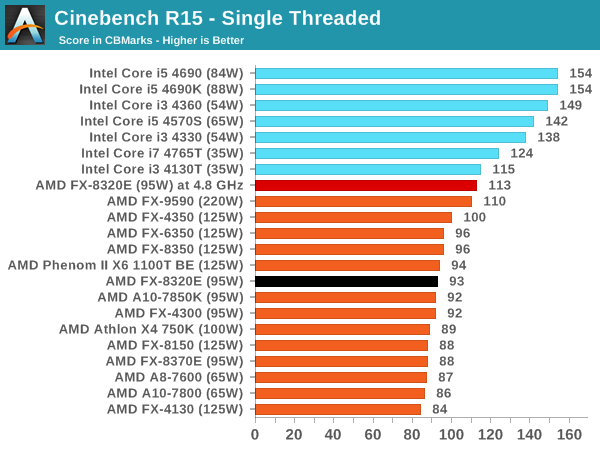
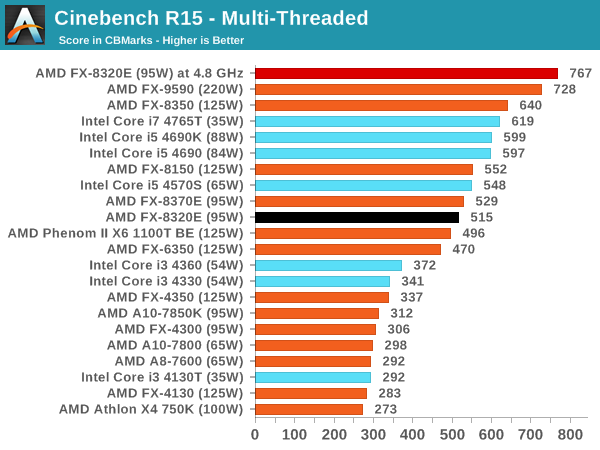
Professional Performance: Linux
Built around several freely available benchmarks for Linux, Linux-Bench is a project spearheaded by Patrick at ServeTheHome to streamline about a dozen of these tests in a single neat package run via a set of three commands using an Ubuntu 14.04 LiveCD. These tests include fluid dynamics used by NASA, ray-tracing, molecular modeling, and a scalable data structure server for web deployments. We run Linux-Bench and have chosen to report a select few of the tests that rely on CPU and DRAM speed.
C-Ray: link
C-Ray is a simple ray-tracing program that focuses almost exclusively on processor performance rather than DRAM access. The test in Linux-Bench renders a heavy complex scene offering a large scalable scenario.
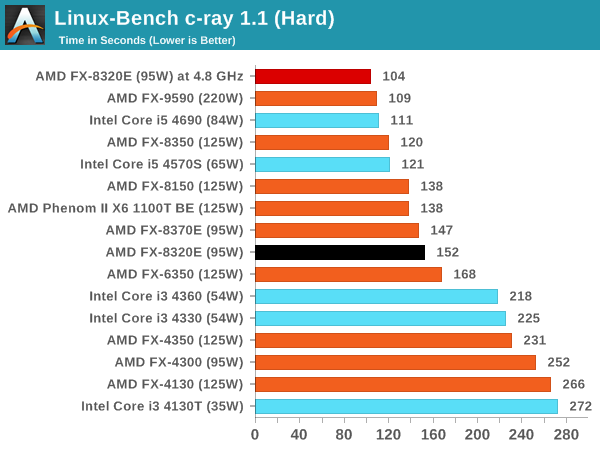
Ahead of the i3, behind the i5 until overclocked seems to be a good motto for this CPU.
NAMD, Scalable Molecular Dynamics: link
Developed by the Theoretical and Computational Biophysics Group at the University of Illinois at Urbana-Champaign, NAMD is a set of parallel molecular dynamics codes for extreme parallelization up to and beyond 200,000 cores. The reference paper detailing NAMD has over 4000 citations, and our testing runs a small simulation where the calculation steps per unit time is the output vector.
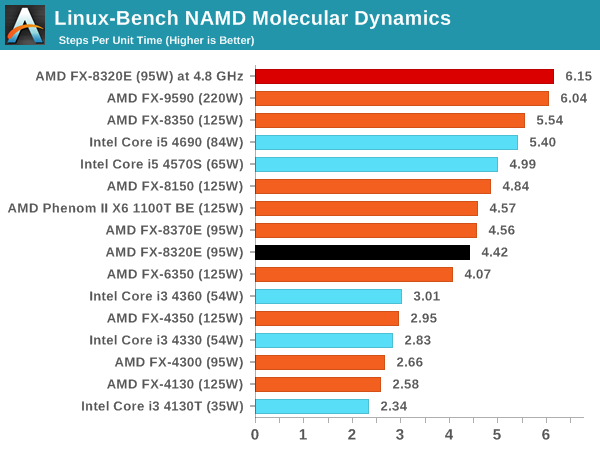
NPB, Fluid Dynamics: link
Aside from LINPACK, there are many other ways to benchmark supercomputers in terms of how effective they are for various types of mathematical processes. The NAS Parallel Benchmarks (NPB) are a set of small programs originally designed for NASA to test their supercomputers in terms of fluid dynamics simulations, useful for airflow reactions and design.
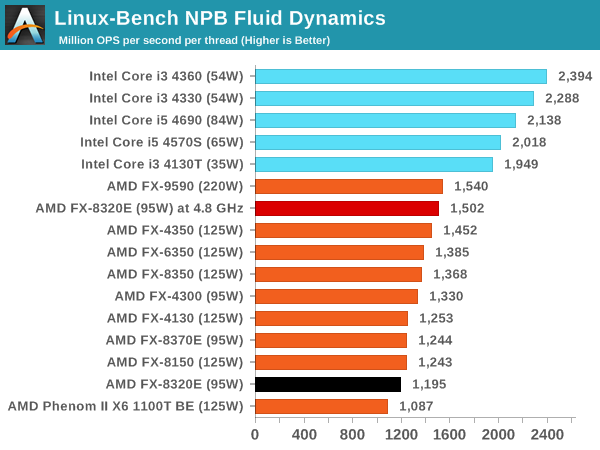
Redis: link
Many of the online applications rely on key-value caches and data structure servers to operate. Redis is an open-source, scalable web technology with a b developer base, but also relies heavily on memory bandwidth as well as CPU performance.
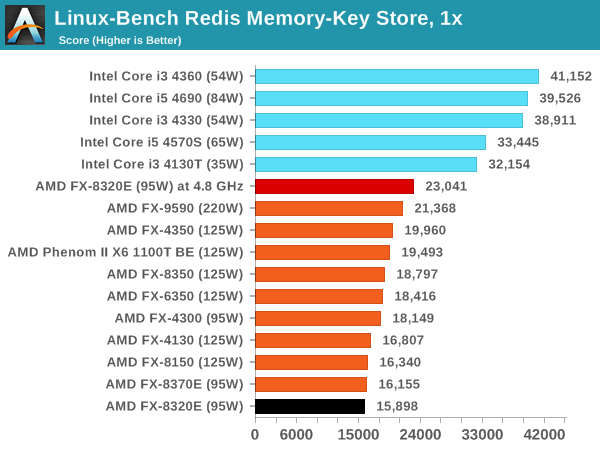
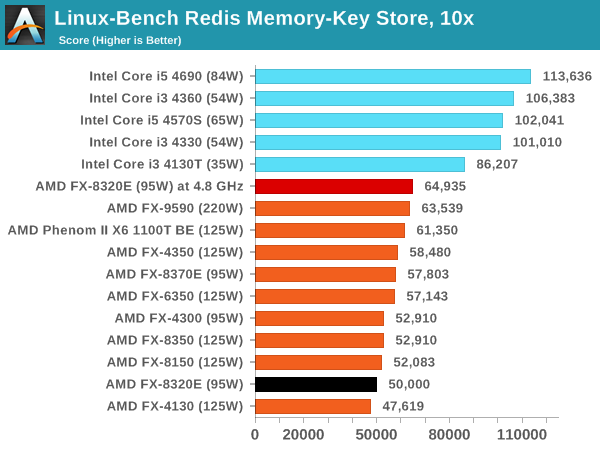
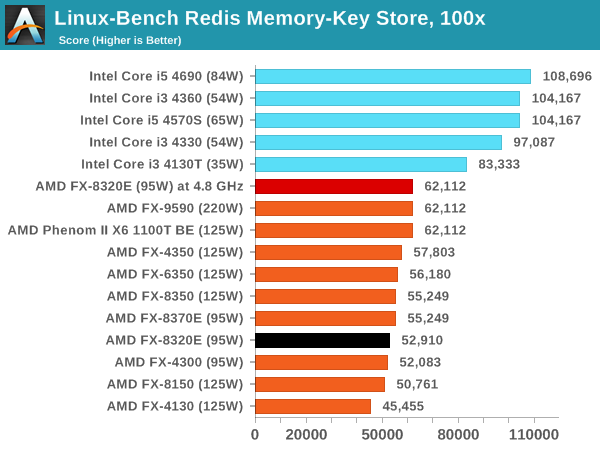
It would seem that one downside to the AMD FX line is the memory access limited scenarios, unless more cores can come into the equation. For redis, that is unfortunately not the case.










92 Comments
View All Comments
Kevin G - Tuesday, January 13, 2015 - link
Updating the chipset is necessary to get new IO on to a platform. Things like USB 3.0 can then be integrated into the chipset so that a 3rd party controller is no longer needed.Rather the nice thing is that AMD hasn't changed socket in 5 years with AM3+. Intlel on the other hand has had three sockets of chips with dual channel DDR3, 16 PCIe lanes and DMI to the chipset. Sure, a few things changed between socket 1156, 1155 and socket 1150, but it would have been nice if Intel was forward thinking and maintained compatibility. The quad core Lynfield chips are still respectable in terms of CPU performance today.
Penti - Tuesday, January 13, 2015 - link
They has basically frozen their whole platform with the failed Bulldozer release. Their chipset's hasn't changed much since AM2+/AM3 days, the NB is basically the same as the 2007 790FX. The only thing 990FX added over 790FX is probably the IOMMU-support (and updated the PCIe lanes used by the SB to PCIe 2.0 also called A-link Express) which was first found in the identical 890FX, also IOMMU was found in server chipsets built on the 800-series back in '10. The southbridge on AM3+ hasn't changed since launch and is basically the same as the 2010 SB850. It's planned that they have a 4 year or so gap. They canceled a lot of designs and plans. Including new server socket and server chipset. They scrapped the plans for new BD chips for AM3+/successor socket also which is why you have no Steamroller or Excavator, and why you have no 10/20-core 2-gen Bulldozer/Piledriver for servers. So the chipset is really 5 years old and based on the same tech as 7 year old NB built on the same process and had HT3 support back then too. So the NB is really 2007-era with minor changes, SB has no USB3 support.Intel basically did have a platform which didn't get a chipset update for ~3 years – the X79. That wasn't such a good deal thanks to no native USB3 support, few SATA6 ports and so on. Lots of bugs too.
stefantalpalaru - Tuesday, January 13, 2015 - link
Here are a series of benchmarks I did on the same (rather modest) motherboard with a Phenom II X6 at 3.9 GHz and the FX-8320E at stock frequency and a 4.5 GHz overclock: http://openbenchmarking.org/result/1412036-KH-MERG...mikato - Wednesday, January 14, 2015 - link
Very cool! Thanks for this. If I interpret the colors correctly, it looks like the X6 wins mostly, but when the FX-8320E is overclocked, it wins mostly.LarsBars - Saturday, January 17, 2015 - link
I used some of the sorting tools and it looks like your summary is correct.But keep in mind that the Phenom II X6 is overclocked... so it's kind of hard to draw conclusions from it. I guess it would have made sense if it was stock vs stock (which we sort of already have in the AT article) or OC vs OC (since AT didn't OC an X6).
$0.02
SpaceRanger - Tuesday, January 13, 2015 - link
The only graph that I wanted to see was the power consumption graph, and it's not included.. :(I really wanted to see just how much they chopped off the power consumption with this go-around.
silverblue - Tuesday, January 13, 2015 - link
Toms benched the 8370E and appeared to get some very interesting power readings. Though this doesn't necessarily ring true for the 8320E, it may be helpful nonetheless:http://www.tomshardware.com/reviews/amd-fx-8370e-c...
sonicmerlin - Tuesday, January 13, 2015 - link
The most painful aspect of AMD's single threaded performance woes is that Intel hasn't even bothered with increasing IPC since Sandy Bridge. AMD needs their new architecture to be a smash hit if they want to avoid bankruptcy.silverblue - Tuesday, January 13, 2015 - link
And that's what bothers me about Carrizo not coming to the desktop. We don't know if that 30% IPC boost is across the board or mainly as a result of FPU gains, but at the very least, Carrizo should bury Phenom II and previous Bulldozer designs, and at least equal Lynnfield/Nehalem, at the same clocks but for far lower power consumption. Still, performance wise, it's not exactly a lofty goal - you'd need more than four cores for that.xenol - Tuesday, January 13, 2015 - link
Software most people use didn't take advantage of Bulldozer because they weren't multi-threaded. It's because software most people use don't take advantage of CPU performance period. Most of the programs in your task manager idle.Modern software is multi-threaded, as in, they have multiple threads. And all the major OSes (Windows, Linux, Mac OS X) schedule at the thread level on any available resource. If they don't take advantage of multiple cores, it's not because they are "single threaded", it's because what they do isn't very taxing for a CPU to do.